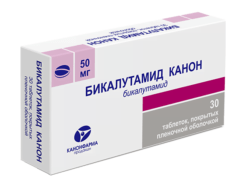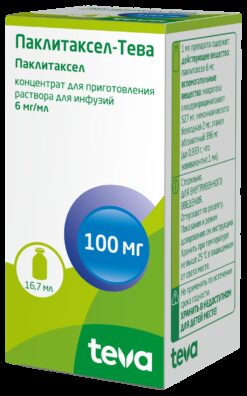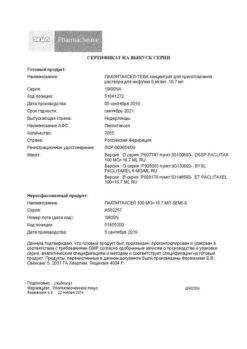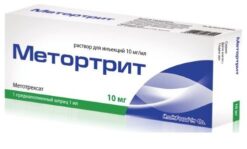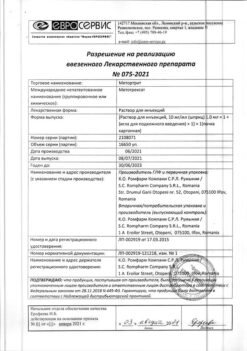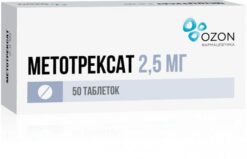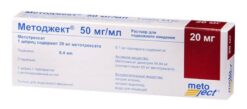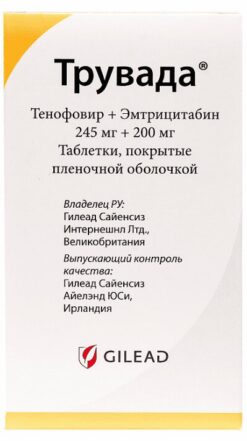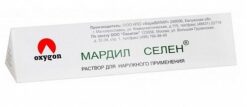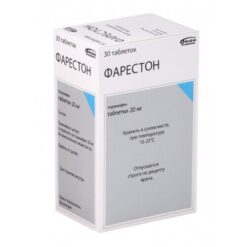No products in the cart.
Description
Pharmacodynamics
Antitumor drug. Being a selective inhibitor of epidermal growth factor receptor tyrosine kinase, which is expressed in many solid tumors, inhibits tumor growth, metastasis and angiogenesis as well as accelerates apoptosis of tumor cells.
Inhibits the growth of various human tumor cell lines and increases the antitumor activity of chemotherapeutic drugs, radiation and hormone therapy.
The clinical data suggest that Iressa® has an objective antitumor effect and statistically significantly increases time to disease progression in patients with locally advanced or metastatic non-small cell lung cancer.
Iressa®, compared with docetaxel, has been shown to provide similar overall survival, a more favorable tolerability profile and superior quality of life in previously treated patients with advanced non-small cell lung cancer.
Patients who have never smoked, have an adenocarcinoma tumor morphologic variant, are female, or are of Asian race are more likely to benefit from Iressa® therapy. These clinical characteristics are also associated with a high frequency of epidermal tumor growth factor receptor mutations.
. When comparing Iressa® and carboplatin + paclitaxel combination in first-line therapy of advanced non-small cell lung cancer (stage IIIB and IV) in Asian patients with adenocarcinoma tumor histology with a history of heavy smoking (who had quit smoking ≥15 years ago and smoked ≤10 packs per year), Iressa® demonstrated statistically significant benefits in progression-free survival and objective response compared to the carboplatin + paclitaxel combination, both in the entire group and in the group of patients in whom epidermal growth factor receptor mutations were identified.
Pharmacokinetics
Intake
After oral administration, absorption is relatively slow. Cmax in blood plasma is reached within 3-7 hours. Absolute bioavailability is on average 59%. Food intake does not affect the bioavailability of the drug. When gastric pH index is higher than 5, the bioavailability of gefitinib decreased by 47%.
Distribution
The regular use of the drug 1 time/day leads to an increase in the concentration by 2-8 times compared to a single dose. Css is reached after 7-10 doses.
The Vd of gefitinib when Css is reached is 1400 L, indicating extensive distribution of the drug in the tissues.
The binding to plasma proteins (serum albumin and α1-glycoprotein) is approximately 90%.
Metabolism
Gefitinib undergoes oxidative metabolism via CYP3A4 isoenzyme.
The metabolism of gefitinib occurs in three ways: metabolism of the N-propylmorpholine group, demethylation of the methoxyl group to the quinazoline portion, and oxidative dephosphorylation of the halogenated phenyl group.
The main metabolite detected in human plasma is O-desmethylhefitinib. The metabolite has 14 times less activity than gefitinib against epidermal growth factor-stimulated cell growth, which makes it unlikely to have a significant effect on the clinical activity of gefitinib.
Elimination
The total plasma clearance of gefitinib is approximately 500 mL/min. T1/2 is on average 41 h. The drug is excreted mainly in the feces. Less than 4% of the administered dose is excreted in the urine.
Pharmacokinetics in special clinical cases
There is no association between the lower Css level of the drug and age, body weight, sex, ethnicity or creatinine clearance.
On daily administration of Iressa at a dose of 250 mg Css, time to reach and total plasma clearance were similar for the groups of patients with normal liver function and with moderate hepatic impairment. Data from 4 patients with severe hepatic failure due to liver metastases suggest that Css in these patients is similar to that in patients with normal liver function.
The specific pharmacokinetics of gefitinib in patients with impaired liver function due to cirrhosis or hepatitis have not been studied.
Indications
Indications
Locally advanced or metastatic non-small cell lung cancer with the presence of activating mutations in the tyrosine kinase domain of the epidermal growth factor receptor in the first line of therapy;
locally advanced or metastatic non-small cell lung cancer, refractory to chemotherapy regimens containing platinum derivatives.
Pharmacological effect
Pharmacological effect
Pharmacodynamics
Antitumor drug. Being a selective inhibitor of epidermal growth factor receptor tyrosine kinase, the expression of which is observed in many solid tumors, it inhibits tumor growth, metastasis and angiogenesis, and also accelerates the apoptosis of tumor cells.
Inhibits the growth of various human tumor cell lines and increases the antitumor activity of chemotherapy drugs, radiation and hormonal therapy.
Clinical data indicate that Iressa® has an objective antitumor effect and statistically significantly increases the time to disease progression in patients with locally advanced or metastatic non-small cell lung cancer.
Iressa®, compared with docetaxel, has been shown to provide similar overall survival, a more favorable tolerability profile and superior quality of life in previously treated patients with advanced non-small cell lung cancer.
Patients who have never smoked, have a morphological variant of the tumor adenocarcinoma, are female, or are representatives of the Asian race are more likely to benefit from therapy with Iressa®. These clinical characteristics are also associated with a high incidence of tumor epidermal growth factor receptor mutations.
When comparing the drug Iressa® and the combination of carboplatin + paclitaxel in the first line of treatment of advanced non-small cell lung cancer (stages IIIB and IV) in Asian patients with histological form of the tumor adenocarcinoma with a clear history of smoking (quit smoking ≥15 years ago and smoked ≤ 10 packs per year), Iressa® demonstrated statistically significant advantages in progression-free survival and objective response compared with the combination of carboplatin + paclitaxel, both in the entire group and in the group of patients in whom epidermal growth factor receptor mutations were identified.
Pharmacokinetics
Suction
After oral administration, absorption is relatively slow. Cmax in blood plasma is achieved within 3–7 hours. Absolute bioavailability averages 59%. Food intake does not affect the bioavailability of the drug. When gastric pH was above 5, the bioavailability of gefitinib decreased by 47%.
Distribution
Regular use of the drug once a day leads to an increase in concentration by 2-8 times compared to a single dose. Css is achieved after taking 7-10 doses.
The Vd of gefitinib upon reaching Css is 1400 L, which indicates extensive distribution of the drug in tissues.
Plasma protein binding (serum albumin and α1-glycoprotein) is approximately 90%.
Metabolism
Gefitinib undergoes oxidative metabolism via the CYP3A4 isoenzyme.
Gefitinib is metabolized through three pathways: metabolism of the N-propylmorpholine group, demethylation of the methoxy group to a quinazoline moiety, and oxidative dephosphorylation of the halogenated phenyl group.
The main metabolite detected in human plasma is O-desmethylgefitinib. The metabolite has 14 times less activity than gefitinib against epidermal growth factor-stimulated cell growth, making it unlikely to have a significant effect on the clinical activity of gefitinib.
Removal
The total plasma clearance of gefitinib is approximately 500 ml/min. T1/2 averages 41 hours. The drug is excreted mainly in feces. Less than 4% of the administered dose is excreted in the urine.
Pharmacokinetics in special clinical situations
There was no association between drug trough Css levels and age, weight, gender, ethnicity, or creatinine clearance.
When Iressa was taken daily at a dose of 250 mg Css, the time to achieve it and total plasma clearance were similar for groups of patients with normal liver function and with moderate liver failure. Data from 4 patients with severe liver failure due to liver metastases suggest that the Css in these patients is similar to that in patients with normal liver function.
The pharmacokinetics of gefitinib in patients with impaired liver function due to cirrhosis or hepatitis have not been studied.
Special instructions
Special instructions
When deciding whether to prescribe Iressa® in the first line of treatment for locally advanced or metastatic non-small cell lung cancer, it is recommended to determine the EGFR (epidermal growth factor receptor) mutation in tumor tissue in all patients. To detect mutations, it is important that a validated and reliable method is selected to minimize the possibility of both false-negative and false-positive results. In first-line therapy, Iressa® cannot be used instead of chemotherapy in patients without an EGFR mutation.
Interstitial lung disease, in some cases fatal, has occasionally occurred in patients taking Iressa®. If symptoms such as shortness of breath, cough, or fever increase, the use of the drug should be discontinued and an examination should be carried out immediately. If the patient is confirmed to have interstitial pulmonary disease, Iressa® is discontinued and the patient is prescribed appropriate treatment.
The development of interstitial lung lesions was most common in Japan (approximately 2% of cases in 27,000 patients taking Iressa®) compared with other countries (0.3% of cases in 39,000 patients).
Among the factors that increase the risk of developing interstitial lung disease were: smoking, severe general condition (PS > 2), normal lung tissue according to computed tomography <50%, disease duration (non-small cell lung cancer) 55 years), concomitant cardiovascular diseases.
While taking Iressa®, an asymptomatic increase in the activity of liver transaminases and bilirubin levels was noted, and hepatitis rarely developed. Isolated cases of liver failure, in some cases fatal, have been reported. Therefore, it is recommended to periodically evaluate liver function. If there is a marked increase in transaminase activity and bilirubin levels, the drug should be discontinued.
Cardiovascular complications were observed in clinical studies of Iressa®. A relationship with the use of Iressa® has not been established.
In patients taking warfarin, prothrombin time should be regularly monitored.
If any eye symptoms occur or if severe or prolonged diarrhea, nausea, vomiting or anorexia develops, the patient should consult a doctor immediately.
When Iressa was used in combination with radiation therapy as first-line therapy in children with brainstem glioma or non-radically resected supratentorial glioma, 4 cases (one fatal) of cerebral hemorrhage were reported. Another case of cerebral hemorrhage was observed in a child with ependymoma during monotherapy with Iressa®. In adult patients with non-small cell lung cancer, such side effects were not recorded in any case during treatment with Iressa®.
Isolated cases of gastrointestinal perforation have been reported in patients with risk factors such as concomitant use of steroids, NSAIDs, a history of peptic ulcer disease, advanced age, smoking, and the presence of metastases in the colon at the site of perforation. However, a cause-and-effect relationship between these phenomena and taking Iressa® has not been established.
Patients with rare hereditary diseases such as lactose intolerance, lactase deficiency or malabsorption syndrome should be prescribed Iressa with caution due to the presence of lactose.
Impact on the ability to drive vehicles and other mechanisms that require increased concentration
Since side effects such as asthenia, nausea and vomiting may develop during therapy with Iressa®, care must be taken when driving a car and engaging in other potentially hazardous activities that require increased concentration and speed of psychomotor reactions.
Active ingredient
Active ingredient
Gefitinib
Composition
Composition
Active ingredient: gefitinib 250 mg.
Excipients:
lactose monohydrate – 163.5 mg,
microcrystalline cellulose – 50 mg,
croscarmellose sodium – 20 mg,
povidone (K29-32) – 10 mg,
sodium lauryl sulfate – 1.5 mg,
magnesium stearate – 5 mg.
Film shell composition:
hypromellose – 7.65 mg, macrogol 300 – 1.5 mg, iron oxide red (E172) – 0.9 mg, iron oxide yellow (E172) – 0.9 mg, titanium dioxide (E171) – 0.5 mg.
Pregnancy
Pregnancy
The use of Iressa® is contraindicated during pregnancy and lactation.
Men and women of childbearing age should use reliable methods of contraception while taking Iressa and for at least 3 months after treatment.
Contraindications
Contraindications
Pregnancy;
lactation period;
childhood and adolescence (safety and effectiveness in this group of patients have not been assessed);
hypersensitivity to gefitinib or other components of the drug.
With caution: the drug should be prescribed for idiopathic pulmonary fibrosis, interstitial pneumonia, pneumoconiosis, post-radiation pneumonia, drug-induced pneumonia (an increased mortality rate from these diseases was noted during treatment with Iressa®); with a slight or moderate increase in the activity of liver transaminases and bilirubin levels.
Side Effects
Side Effects
The most common side effects, observed in more than 20% of cases, were diarrhea, skin and acne rashes, itching, and dry skin.
Typically, adverse reactions appear within the first month of using the drug and are usually reversible. Approximately 10% of patients experienced serious adverse reactions (grade 3-4 severity according to the general toxicity criteria).
However, only 3% of patients had therapy discontinued due to adverse reactions.
The observed adverse reactions are presented below.
Determination of the frequency of adverse reactions:
very often (≥10%);
often (≥1% – <10%);
uncommon (≥0.1% - <1%);
rare (≥0.01% - <0.1%).
From the blood coagulation system: often – hematuria and nosebleeds; uncommon – hypocoagulation and/or increased bleeding while taking warfarin.
From the digestive system: very often – diarrhea (in some cases severe), nausea (mostly mild or moderate), vomiting (mostly mild or moderate), stomatitis (mostly mild), anorexia (mild or moderate), increased ALT activity (mostly mild or moderate); often – dehydration (due to diarrhea, nausea, vomiting and anorexia), dry mouth (mostly mild), increased AST activity (mostly mild or moderate), increased bilirubin levels (mostly mild or moderate); infrequently – pancreatitis, hepatitis (isolated cases of liver failure have been reported, in some cases with death).
From the organ of vision: often – conjunctivitis, blepharitis, xerophthalmia (mostly mild); infrequently – reversible corneal erosion, impaired eyelash growth.
From the respiratory system: often – interstitial pneumonia (grade 3-4 toxicity, including death).
From the urinary system: often – asymptomatic increase in the level of creatinine in the blood, proteinuria.
Dermatological reactions: very often – rash (pustular), itching, dry skin, including the formation of cracks against the background of erythema; often – nail changes, alopecia; rarely – bullous skin changes, including toxic epidermal necrolysis, Stevens-Johnson syndrome and erythema multiforme exudative, cutaneous vasculitis.
Allergic reactions: uncommon – angioedema, urticaria.
Other: very often – asthenia (mostly mild), often – increased body temperature.
Interaction
Interaction
Co-administration of gefitinib and rifampicin (a strong CYP3A4 inducer) resulted in an 83% reduction in mean gefitinib AUC values.
Co-administration of gefitinib and itraconazole (an inhibitor of the CYP3A4 isoenzyme) leads to an 80% increase in the AUC of gefitinib, which may be clinically significant because Adverse events are dose and concentration dependent.
Co-administration of gefitinib and drugs that cause significant (≥5) and prolonged increases in gastric pH resulted in a 47% decrease in gefitinib AUC.
When gefitinib and vinorelbine are used together, the neutropenic effect of vinorelbine may be enhanced.
Drugs that induce the activity of the CYP3A4 isoenzyme may increase metabolism and reduce plasma concentrations of gefitinib. Thus, simultaneous administration of gefitinib with drugs that induce the CYP3A4 isoenzyme, such as phenytoin, carbamazepine, barbiturates, St. John’s wort tincture, may reduce the effectiveness of gefitinib.
Overdose
Overdose
Symptoms: increased frequency and severity of certain adverse reactions, mainly diarrhea and skin rash.
Treatment: carry out symptomatic therapy. No antidote is known.
Storage conditions
Storage conditions
At a temperature not exceeding 30 °C
Manufacturer
Manufacturer
Nipro Pharma Corporation, Japan
Additional information
| Conditions of storage | At a temperature not exceeding 30 °C |
|---|---|
| Manufacturer | Nipro Pharma Corporation, Japan |
| Medication form | pills |
| Brand | Nipro Pharma Corporation |
Related products
Buy Iressa, 250 mg 30 pcs. with delivery to USA, UK, Europe and over 120 other countries.





